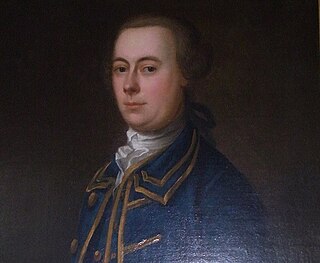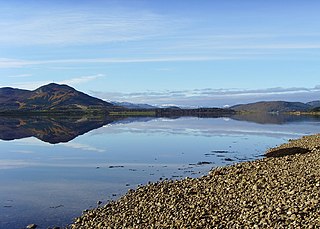
The Battle of Culloden was the final confrontation of the Jacobite rising of 1745. On 16 April 1746, the Jacobite army of Charles Edward Stuart was decisively defeated by a British government force under Prince William Augustus, Duke of Cumberland, on Drummossie Moor near Inverness in the Scottish Highlands. It was the last pitched battle fought on British soil.

Clan Campbell is a Highland Scottish clan, historically one of the largest and most powerful of the Highland clans. The Clan Campbell lands are in Argyll and within their lands lies Ben Cruachan. The chief of the clan became Earl of Argyll and later Duke of Argyll.

Anne Mackintosh (1723–1784) was a Scottish Jacobite of the Clan Farquharson, a Scottish clan of the Scottish Highlands and also the wife of Angus Mackintosh, chief of the Clan Mackintosh. She was the only female military leader during the Jacobite rising of 1745 and the first female to hold the rank of colonel in Scotland.

Clan Cameron is a West Highland Scottish clan, with one main branch Lochiel, and numerous cadet branches. The Clan Cameron lands are in Lochaber and within their lands lies Ben Nevis which is the highest mountain in the British Isles. The Chief of the clan is customarily referred to as simply "Lochiel".

Sir Harry Munro, 7th Baronet was 25th Baron and the 28th chief of the Clan Munro. He was a Scottish soldier and politician. He was loyal to the Hanoverian dynasty and served as a captain in Loudon's Highlanders Regiment 1745–48.

Clan MacLaren is a Highland Scottish clan. Traditional clan lands include the old parish of Balquhidder which includes the villages of Lochearnhead and Strathyre, and is about 18 miles (29 km) long and 7 miles (11 km) broad, spanning 54,675 acres (22,126 ha), long known as "Maclaren Country".

Donald Cameron of Lochiel, popularly known as the Gentle Lochiel, was a Scottish Jacobite, soldier and hereditary chief of Clan Cameron, traditionally loyal to the exiled House of Stuart. His support for Prince Charles Edward Stuart proved pivotal in the early stages of the 1745 Jacobite Rising. Lochiel was among the Highlanders defeated at the Battle of Culloden, and thereafter fled to France.
Sir George Munro of Culcairn was a Scottish soldier of the 18th century from Ross-shire, Scotland. He commanded the 3rd Independent Highland Company from 1714 to 1716, fought at the Battle of Glen Shiel in 1719, led the 6th Company in formation of the "Black Watch" in 1725, the 8th Company of Black Watch when it was regimented in 1739 and again commanded an Independent Highland Company in 1745–46. He was shot in error in 1746.

The Battle of Littleferry took place during the Jacobite rising in 1746, just before the Battle of Culloden. Scottish forces loyal to the British-Hanoverian Government defeated a Scottish Jacobite force.

Clan Munro is a Highland Scottish clan. Historically the clan was based in Easter Ross in the Scottish Highlands. Traditional origins of the clan give its founder as Donald Munro who came from the north of Ireland and settled in Scotland in the eleventh century, though its true founder may have lived much later. It is also a strong tradition that the Munro chiefs supported Robert the Bruce during the Wars of Scottish Independence. The first proven clan chief on record however is Robert de Munro who died in 1369; his father is mentioned but not named in a number of charters. The clan chiefs originally held land principally at Findon on the Black Isle but exchanged it in 1350 for Estirfowlys. Robert's son Hugh who died in 1425 was the first of the family to be styled "of Foulis", despite which clan genealogies describe him as 9th baron.

The Skirmish of Tongue was a battle that took place in March 1746 near Tongue in the Scottish Highlands during the Jacobite Rising of 1745.
The Independent Highland Companies were irregular militia raised from the Scottish clans of the Scottish Highlands by order of the British government between 1603 and 1760 in order to help keep the peace and enforce the law in the Highlands and were recognized as such by the government. The officers of the Independent Highland Companies were commissioned as officers of the British Army but the Independent Companies were not recognized as official regiments of the line of the army. The Independent Highland Companies were the progenitors of the Highland Regiments of the British Army that began when ten Independent Highland Companies were embodied to form the Earl of Crawford's Highland Regiment that was numbered the 43rd Regiment of Foot in 1739.
The Campbell of Argyll Militia also known as the Campbell militia, the Argyll militia, or the Argyllshire men, was an irregular militia unit formed in 1745 by John Campbell, 4th Duke of Argyll to oppose the Jacobite rising of 1745.

The Battle of Dornoch took place on 20 March 1746 and was part of the Jacobite rising of 1745 in Scotland. However, although recorded in history as a "battle" there was no actual fighting between the two sides. Instead a large rebel Jacobite force advanced on a position held by a force loyal to the British-Hanoverian Government who were taken by surprise and forced into a retreat. The Jacobite advance was coordinated by James Drummond, 3rd Duke of Perth at Dornoch, Sutherland.

The Raids on Lochaber and Shiramore took place in the Scottish Highlands between 22 May and 31 August 1746 and were part of the closing operations of the British-Hanoverian Government to bring to an end the Jacobite rising of 1745. Sometimes referred to as the "mopping up" operations, many rebels surrendered themselves and their arms, while others were captured and punished. It also included the hunt for the Jacobite leader Bonnie Prince Charles Edward Stuart otherwise known as the Young Pretender. Most of the work was done on behalf of the Government by the Independent Highland Companies of militia, the Campbell of Argyll Militia and also Loudon's Highlanders regiment.
George Mackay, 3rd Lord Reay (1678–1748), was a Scottish noble and chief of the Clan Mackay, a Scottish clan of the Scottish Highlands. During his life the Glorious Revolution took place which directly affected his family and estate, and during his chiefdom he served the British-Hanoverian Government during the Jacobite rising of 1715 and the Jacobite rising of 1745.

The siege of Culloden House took place on the night of 15/16 October 1745 and was part of the Jacobite rising of 1745. 200 men of the Jacobite Clan Fraser of Lovat attempted to capture Duncan Forbes, Lord Culloden who was the Lord President of the Court of Session, the most senior legal officer in Scotland.

Duncan Forbes of Culloden was a Scottish lawyer and Whig politician who sat in the House of Commons from 1721 to 1737. As Lord President and senior Scottish legal officer, he played a major role in helping the government suppress the 1745 Jacobite Rising.

An Incident in the Rebellion of 1745 is an oil painting, by the Anglo-Swiss artist David Morier. It is part of the art collection of the British royal family. The painting depicts a scene during the 1746 Battle of Culloden, in which a group of Jacobite Army troops charge against a line of government soldiers.

Regimental tartans are tartan patterns used in military uniforms, possibly originally by clan militias in Scotland, certainly later by the Highland regiments and many Lowland regiments of the British Army, and eventually by some military units in other countries. The earliest evidence suggesting militia uniform tartans dates to 1691, and the first certain uniform tartan was that of the Royal Company of Archers in 1713. The Independent Highland Companies (IHCs) raised 1725–29 by the British government appear to have had one or more uniform tartans. The first true Highland regiment of the British Army was the 42nd Regiment of Foot formed by amalgamation of the IHCs in 1739, and had its own consistent unform tartan by 1749 or 1757 at the latest. Some later Highland units also wore this tartan, while others developed minor variations on it, usually by adding bright-coloured over-checks. Some few regiments developed their own tartans not based on Black Watch, including the 75th, 79th, Fraser Fencibles, and Loyal Clan Donnachie Volunteers. Some units developed special tartans for bandsmen and grenadiers.















